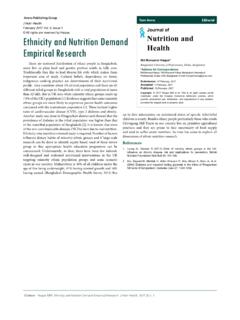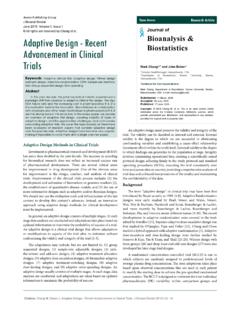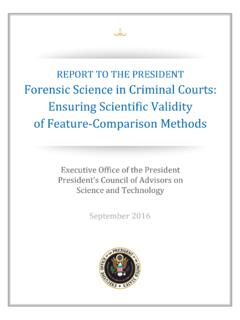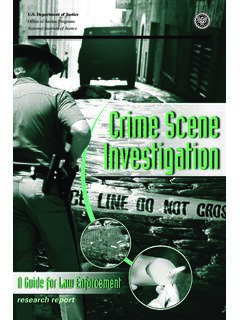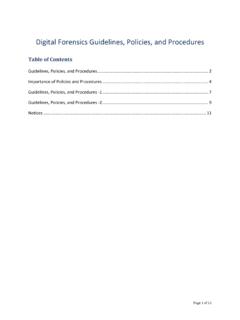Transcription of Forensic Evidence and Crime Scene Investigation
1 Citation: Lee HC, Pagliaro EM. Forensic Evidence and Crime Scene Investigation . J Forensic Investigation . 2013;1(1): Forensic InvestigationSeptember 2013 Vol.:1, Issue:2 All rights are reserved by Lee et Evidence and Crime Scene InvestigationIntroductionContemporary law enforcement has greatly expanded its ability to solve crimes by the adoption of Forensic techniques and procedures [1]. Today, crimes often can be solved by detailed examination of the Crime Scene and analysis of Forensic Evidence [2]. The work of Forensic scientists is not only crucial in criminal investigations and prosecutions, but is also vital in civil litigations, major man-made and natural disasters, and the Investigation of global crimes. The success of the analysis of the Forensic Evidence is based upon a system that emphasizes teamwork, advanced investigative skills and tools (such as GPS positioning, cell phone tracking, video image analysis, artificial intelligence and data mining), and the ability to process a Crime Scene properly by recognizing, collecting and preserving all relevant physical Evidence [3].
2 Recognition of physical Evidence is a vital step in the process. If potential physical Evidence is not recognized, collected or properly preserved and tested, the Forensic value of the Evidence may be greatly reduced or even lost forever. Numerous routine and high profile cases have demonstrated the harsh reality that despite the availability of current Crime Scene technologies, specialized equipment, and sophisticated Forensic laboratory analysis, the effective utilization of physical Evidence in Crime solving is only as good as the knowledge and integrity of the Crime Scene personnel1 and the objective legal system that supports those functions [4]. In some cases, Evidence has been falsified or results tainted, misleading the justice system [5,6].Scientific Crime Scene InvestigationCurrently, most of the textbooks in the field limit the Crime Scene Investigation to the documentation of the Crime Scene and the subsequent collection and packaging of the physical Evidence .
3 Those who work the Crime Scene have unfortunately been labeled Crime Scene technicians, and often are only involved in the Crime Scene security, documentation of the Crime Scene and the collection and preservation of the physical Evidence from the Crime Scene [7]. Documentation of the Crime Scene and the collection of physical Evidence are important aspects of the Crime Scene Investigation and, certainly, must be properly performed. The completion of these Crime Scene tasks is essential in maintaining the integrity of the physical Evidence and providing the final outcome of the criminal Investigation . However, these activities are purely mechanical tasks and any individual with minimal training can perform these tasks with moderate precision [8].
4 While these tasks are extremely important, they have a limited direct value on the solution of a Crime Scene Investigation is a process that not only includes the above mechanical aspects of Scene security, Crime Scene documentation, and physical Evidence collection and preservation, but also demands and expects more dynamic approaches such as Scene survey, Scene analysis, development of hypotheses through the linkage of the Scene , physical Evidence and persons, and the 1 See CSI ON TRIAL where a false confession and faked Evidence by a seasoned Crime Scene investigator are addressed in a double homicide case in Nebraska. (Available at )reconstruction of the Crime Scene [9]. Even in agencies where the Crime Scene tasks are assigned by levels, all personnel working a Crime Scene must be aware of the dynamic nature of a Crime Scene and the importance of linkage and hypothesis development.
5 Crime Scene Investigation is based on scientific reasoning. That means that the Investigation of the Crime Scene is systematic, methodical and logical. It begins with the initial response to a Crime Scene and continues through the Scene security, the Crime Scene documentation, the recognition of physical Evidence , the enhancement of patterns, the physical Evidence collection, packaging and preservation, the physical Evidence examination, the Crime Scene analysis and profile, and ultimately concludes at the Crime Scene reconstruction [9]. Furthermore, systematic Crime Scene Investigation is based not only on the principles of the Locard Transfer Theory2, but also the Linkage Principle3 [9] as shown in Figure 1. The utilization of scientific knowledge in conjunction with the Forensic techniques of physical Evidence examination will generate investigative leads, and thus ultimately solve the Crime .
6 Physical Evidence obtained from the Crime Scene or other segments of the Investigation is often the cornerstone upon which the successful outcome of the case is dependent. Yet, many cases are never solved or prosecuted due to the lack of physical Evidence [10]. On the other hand, some innocent people are arrested and prosecuted because of witness misidentification or the misuse of Forensic Evidence [11]. While it is theoretically possible that a near perfect Crime can be committed in which the perpetrator was able to commit the Crime , leaving minimal Evidence , it is more likely that the critical Evidence was never recognized or found. Many investigators have obtained the necessary expertise to document, collect and preserve various types of physical Evidence .
7 However, the presumed simple task of finding the critical Evidence can often be the failure point of the Crime Scene Investigation . 2 Edmund Locard (1877-1966) was a French criminologist who established the first police Crime lab. Locard s Transfer Theory states that the contact between two entities results in a mutual exchange of materials, which can be identified and analyzed by the Forensic Linkage is a connection, relationship or association between objects and /or persons. The linkage theory explains the interrelations between a Crime Scene , a victim, a suspect and physical Evidence . Understanding and appreciating these connections between these components will provide guidance in determining where Evidence may be located and the need to identify Evidence so that the linkages may be established.
8 Henry C. Lee1* and Elaine M. Pagliaro21 Distinguished Professor, University of New Haven; Founder, Henry C. Lee Institute of Forensic Science, USA 2 Henry C. Lee Institute, University of New Haven, USA Address for CorrespondenceHenry C. Lee , , Distinguished Professor, University of New Haven, Founder, Henry C. Lee Institute of Forensic Science, USA, Tel: 203-479-4594; Fax: 203-931-6074; E-mail: 10 August 2013 Accepted: 11 September 2013 Published: 13 September 2013 Journal ofForensic InvestigationReview ArticleOpen AccessAvens Publishing GroupInviting InnovationsCitation: Lee HC, Pagliaro EM. Forensic Evidence and Crime Scene Investigation . J Forensic Investigation . 2013;1(1): Forensic Investigation 1(1): 5 (2013) Page - 02 One common practice is to collect everything that could be, in any possible manner, construed as evidentiary in nature [12].
9 This sort of practice is not only a waste of time and resources, but could potentially cause legal and investigative issues; if every object at a Scene is collected and submitted to the Forensic laboratory for further analysis, the Forensic facility will be overwhelmed, and it is more likely that some of the Evidence collected will have no probative value [9]. Examination of materials unrelated to the incident may also provide false leads which will waste valuable resources and may lead to the arrest of the wrong person. On the other hand, the identification of Evidence that has so-called probative value ( Evidence that is proof of or has a tendency to prove a fact at issue) is sometimes the focus of some Crime Scene analysts. Care should be taken when using this approach as well, since valuable Evidence may be overlooked in an effort to prove a hypothesis or link the Scene to a specific suspect.
10 If critical Evidence is omitted or improperly preserved, no type of modern, state-of-the-art laboratory instrumentation and technology will be able to salvage the Investigation [9]. Hence, a system must be developed where the relevant physical Evidence is recognized and located, while superfluous materials are excluded. This will only result if the Crime Scene investigators understand the goals of a Crime Scene search, grasp the concepts and techniques for effective searching, and routinely exercise the discipline necessary to rely on a systematic, structured search process with a completely objective and open physical Evidence has been identified at a Scene , subsequent preservation, handling and analysis must satisfy both scientific and legal requirements if that Evidence is to be considered reliable and useful in court proceedings.

